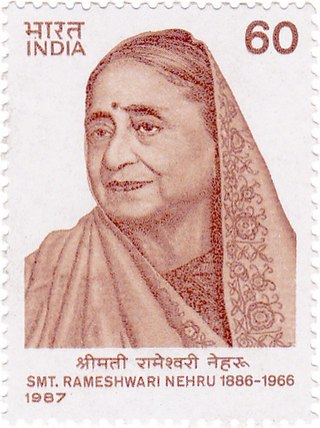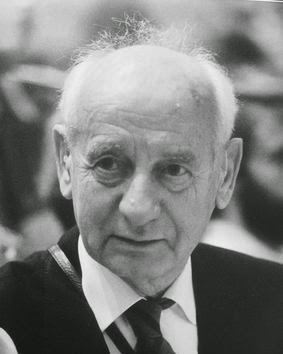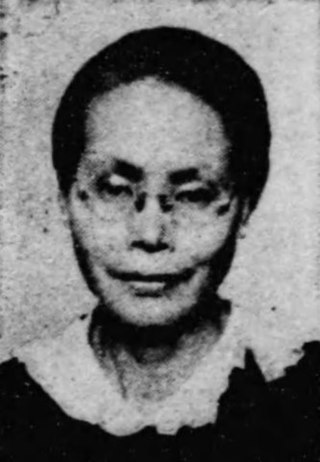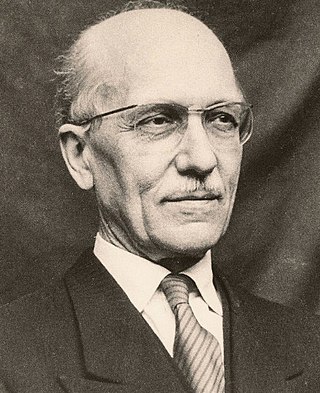Related Research Articles

Alfred Kastler was a French physicist, and Nobel Prize laureate. He is known for the development of optical pumping.

Rameshwari Nehru was a social worker of India. She worked for the upliftment of the poorer classes and of women. In 1902, she married Brijlal Nehru, a nephew of Motilal Nehru and cousin of the first prime minister of independent India, Jawaharlal Nehru. Her son Braj Kumar Nehru was an Indian civil servant who served as governor of several states.

Dickinson Woodruff Richards Jr. was an American physician and physiologist. He was a co-recipient of the Nobel Prize in Physiology or Medicine in 1956 with André Cournand and Werner Forssmann for the development of cardiac catheterization and the characterisation of a number of cardiac diseases.

Erich von Kahler was a mid-twentieth-century European-American literary scholar, essayist, and teacher known for works such as The Tower and the Abyss: An Inquiry into the Transformation of Man (1957).

Ezequiel Padilla Peñaloza was a Mexican statesman. Born in Coyuca de Catalán, Guerrero, he served in the Senate, as Attorney General in 1928, as Secretary of Education from 1928 to 1930, as ambassador to Hungary from 1930 to 1932, and as Secretary of Foreign Affairs from 1940 to 1945. He was the President of the Chamber of Deputies in 1925.
Dana McLean Greeley was a Unitarian minister, the last president of the American Unitarian Association and, upon its merger with the Universalist Church in America, was the founding president of the Unitarian Universalist Association.

Josué de Castro, born Josué Apolônio de Castro, was a Brazilian physician, nutritionist, geographer, writer, public administrator, and activist against world hunger.

Satish Gujral was an Indian painter, sculptor, muralist and writer of the post-independent era. He was awarded the Padma Vibhushan, the second-highest civilian award of the Republic of India, in 1999. His elder brother, Inder Kumar Gujral, was the Prime Minister of India between 1997 and 1998.

Akira Kazami was a Japanese politician. He served as Secretary-General of the First Konoe Cabinet (1937-1939) and Minister of Justice of the Second Konoe Cabinet (1940).

Cornelis "Cees" Berkhouwer was a Dutch politician.
Gerhard Jahn was a German politician and a member of the Social Democratic Party of Germany (SPD). He was Parliamentary Secretary to the Minister for Foreign Affairs from 1967 to 1969, and Federal Minister of Justice from 1969 to 1974.
Hiroo Ōhara was the Governor of Hiroshima Prefecture from 1951 to 1962.

Hisato Ichimada was a Japanese banker and politician who served as Minister of Finance from 1954 to 1956 and 1957 to 1958, and as Governor of the Bank of Japan from 1946 to 1954.

Irène de Lipkowski was a French politician who served as a member of the National Assembly from 1951 to 1955, and as the 8th President of the International Alliance of Women from 1973 to 1979.

Henri Laugier (1888-1973) was a French scholar. He served as the president of the French National Centre for Scientific Research from 1939 to 1940 and from 1943 to 1944.
Edward J. Sparling (1896-1981) was an educator who was the founder of Roosevelt University in Chicago, Illinois.

Chiyo Sakakibara was a Japanese journalist, educator and politician. She was one of the first group of women elected to the House of Representatives in 1946. In 1948 she was appointed Deputy Secretary of Justice, also becoming the first woman appointed to a cabinet post.

Jean François Orcel was a French mineralogist who contributed to the French nuclear energy program following the discovery of Uranium vanadate deposits in Morocco. He served as a mineralogist at the Muséum National d’Histoire Naturelle in Paris. He later specialized in the chemistry of meteorites.
Ahmed Ebrahim Haroon Jaffer was a Pakistani industrialist and politician. He served as a member of the Central Legislative Assembly.

Maurício de Medeiros (1885-1966) was a Brazilian doctor, teacher, writer and politician.
References
- ↑ Saxon, Wolfgang, "Gerard Piel, 89, Who Revived Scientific American Magazine, Dies", The New York Times, obituary, September 07, 2004
- ↑ Shore, Lys Ann (1990). "Skepticism in the Light of Scientific Literacy". Skeptical Inquirer. 15 (1): 8.
- ↑ "Gerard Piel". American Academy of Arts & Sciences. Retrieved 2022-11-09.
- ↑ "APS Member History". search.amphilsoc.org. Retrieved 2022-11-09.
- ↑ The Acceleration of History Alfred A. Knopf, 1972, ISBN 0-394-47312-4
- ↑ "Letters from Thane Read asking Helen Keller to sign the World Constitution for world peace. 1961". Helen Keller Archive. American Foundation for the Blind. Retrieved 2023-07-01.
- ↑ "Letter from World Constitution Coordinating Committee to Helen, enclosing current materials". Helen Keller Archive. American Foundation for the Blind. Retrieved 2023-07-03.
- ↑ "Preparing earth constitution | Global Strategies & Solutions | The Encyclopedia of World Problems". The Encyclopedia of World Problems | Union of International Associations (UIA). Retrieved 2023-07-15.